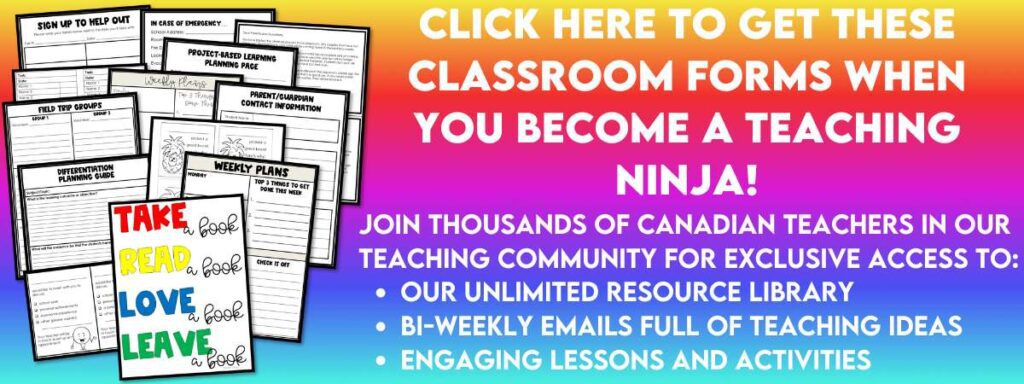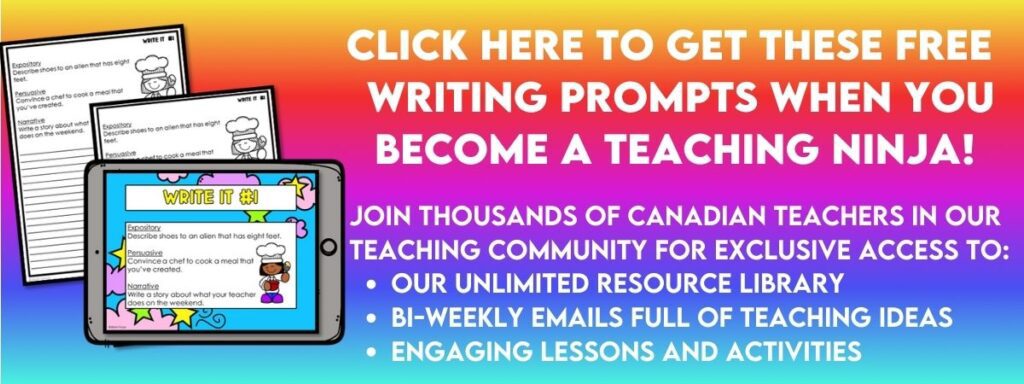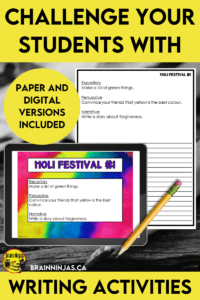
There are generally two reactions that students give when it is time for writing activities in the classroom. Half are usually excited and the other half is filled with dread. We’ve been through lots of different writing programs over the years, been to hundreds of hours of professional development to teach writing and have seen the same pattern over and over again.
Most teachers don’t feel like they know how to teach writing. Is that you? Keep reading.
What Do We Mean By Writing Activities?
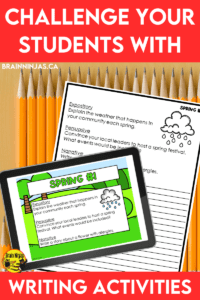
Anything students do which requires them to form words and express them to others is a form of writing. This can be traditional paper and pencil, writing on a word processing document, speaking or recording their voice. It can be assistive technology that translates text to speech or even a set of pictures and images.
Writing activities are not just essays and stories. As soon as you teach this to your students, your battle with the strugglers will be so much easier.
We explain that writers come in lots of different forms and write for lots of different reasons. And not all writers are good at writing all things.
A person who writes amazing graphic novels featuring fantasy characters is probably not a great writer for a technical book on how to operate a vacuum.
But, whether or not a student loves writing can be a challenge so it’s important to show students that writing is a valuable skill that they will use throughout their lives (even if it’s different types of writing than what they are learning at the moment).
Why Write Every Day?
Learning to write is just like any other skill. It takes practice. The problem is that most teachers equate practice with having to write thousands of words at a time.
Instead, try writing for shorter, more meaningful writing activities.
We write every day in our classroom. Sometimes it’s as short as five minutes and other days are much longer. It depends on the task, what we’re trying to practice or if we’re learning something new.
But, our students have learned that writing happens every day. And, sometimes it doesn’t even require physically writing things down.
How to Stop Students From Ever Writing Again
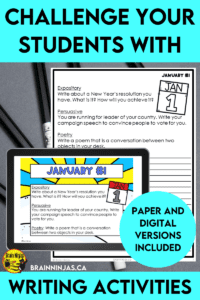
Have you ever tried to do a task and before you get through the first step, someone is already correcting you? Nothing quashes inspiration faster than critiques and bossiness.
As a teacher, this can be challenging since our job is to help students with their craft, but tread lightly with the red pen. Here are some ways to prevent yourself from sabotaging your teaching efforts.
Grading Instead of Feedback
There will always be a time when you have to assess it all, but that’s for the evaluation period, not during the work time. Instead, choose ONE thing students will be working on. There will always be a million things to work on. The little perfectionists in your class will always be hard enough on themselves, so don’t add to the anxiety of it by adding more than is needed.
Instead of correcting. try using feedback that asks a question. This will help the student think about their writing instead of feeling shut down because it’s wrong. We have a whole post on How to Give Student Feedback as well as some feedback prompts we use with our students.
You can also use these free feedback notes to encourage your students and their writing. We can send them directly to your inbox (along with more classroom forms) when you join our mailing list, or you can find them in our Resource Library.
Doing Too Much Writing
Why do students have to write a story from beginning to end every single time? There are no rules about this that we could find.
Instead, we get students to different lengths of writing. Some are longer and some are shorter. We have a variety of writing activities and we mix it up whenever possible.
Good Copies = Twice the Writing
Did you have to write a plan, then a rough draft and then write out or type out a good copy? What a waste of time! And even more, what a way to kill the passion of writing a story.
This doesn’t mean you can’t publish great writing, but real writers don’t rewrite their work by hand over and over. They use a word processor and make changes as they go.
You Hate Writing
Your attitude and passion are contagious, so at least fake love of writing if you don’t have one. This applies to everything you teach. And who knows, you might even start to enjoy it yourself.
Only Use Pencils for Writing Activities
Writing is way more fun when you use a writing tool that’s more fun. Try writing with a marker, a smelly pen or a fancy pencil. Something as simple as switching up the paper can make writing more fun. Try it (it works).
Writing Activities You Can Do in a Hurry
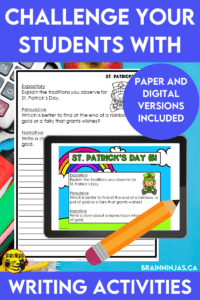
Quick Write
We set a timer and everyone writes for 10-15 minutes. We supply prompts for this, but students don’t have to follow them. Working with our students over the years, we wrote a year’s worth of prompts that have a monthly theme, but allow students to explore narrative, expository and persuasive writing (and sometimes poetry).
Students choose one of the prompts and write about it as the timer counts down.
Sometimes students return to these works and write more or even publish them. Sometimes they share a line or two from their writing and sometimes they just use them as ideas.
We should point out that all the digital versions now come in brightly coloured (non-emergency pandemic-looking ones) instead of the ones pictured in the photos.
Try a writing prompt for free.
Monthly Sets in our Teachers Pay Teachers store ($USD): September, October, November, December, January, February, March, April, May, June, Whole Year Bundle These prompts are also reorganized by genre instead. You can find our Daily Writing Prompts Genre Bundle in our store.
Don’t have any prompts? Just choose a line in any book and write about that. Use the sentence in a story, write a poem or create an expository piece. It can be a part of the writing, the inspiration for the piece of writing.
If you want students to do some writing around a theme or holiday, we have those too.
In our Teachers Pay Teachers Store ($USD): Back to School, Halloween, Thanksgiving, Remembrance Day, Diwali, Christmas, New Year’s, Lunar New Year, Kindness, Valentine’s Day, St. Patrick’s Day, Earth Day, Holi Festival of Colours, Easter, Poetry Month, Women’s History Month, End of the Year, Holiday Bundle.
Seasons: Autumn, Winter, Spring, Summer, Bundle
In our Shopify Store ($CAD): Back to School, Halloween, Thanksgiving, Remembrance Day, Diwali, Christmas, New Year’s, Lunar New Year, Kindness, Valentine’s Day, St. Patrick’s Day, Earth Day, Holi Festival of Colours, Easter, Poetry Month, Women’s History Month, End of the Year.
Seasons: Autumn, Winter, Spring, Summer
List Making
We ask students to make a list of something: candy, video game characters, places they’ve been (it doesn’t matter) and we ask them to write as many things as possible in a given length of time (like 5 minutes).
Instructions to do Something
We ask students to explain how to do something they know how to do (like beat a level in a video game or solve a Rubik’s cube). Students write about things they know. As a result, they are engaged and don’t need to come up with new ideas.
The Best Sentence in the World
We write a boring sentence like “Keisha walked to school.” Students turn the boring sentence into much more exciting sentences like, “While Keisha sauntered along the sidewalk, an immense green dragon slithered out of a nearby tree to ask her if she really needed to go to school.”
Five Finger Story
Each finger represents one sentence of a simple that must have a beginning, middle and end. Students don’t actually write down the story until they have retold it to five people. This helps them refine the story. We also call this one, a one-handed story.
Speech On the Spot
We use these cards to inspire our students to write a speech about something they already know in just a few moments (and they don’t write them down). The telling and retelling of the speech helps students solidify their ideas and we teach our students to use this strategy when they are thinking about what to write.
You can find the Speech on the Spot prompts in our store.
Vocabulary Challenges
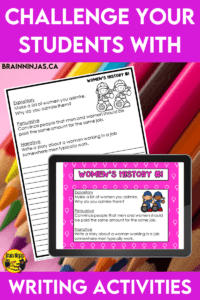
Choose a word your students are overusing in their writing. Our students usually need help with synonyms for walking, said and awesome. Choose one and then have students brainstorm as many new or better words that could be used instead. Give your students some chart paper and smelly markers to amp up the engagement.
Picture Prompts
Find some funny or silly pictures (animals are great) and ask students to write about them. Better yet, ask your student to collect and save images with you so you have a collection to pull from. We do this by having a Google Drive Folder that is shared with our students. They can put items in the folder.
What if Questions
Give students situations that start with What if… What if you were stuck in a hot air balloon? What if there were no trees? Have students come up with the questions one day. We use a simple Google Form to collect ideas from students.
Idea Collection
We make a very simple set of Google Slides where each slide is in one category: character names, places, or interesting problems.
Students use the slides to brainstorm ideas. Sometimes we do this as our writing for the day (it’s a little like list-making, but with a more specific purpose). Other times, we refer to the slides to get ideas for our other writing activities.
Writing Stems in a Bucket
Have a bunch of writing stems printed on strips of paper and place them in a container. You can use the writing prompts we listed under the quick write above or write your own sentence stems like, “When I grow up I want to…” Students choose a stem sentence from the container and then write about that.
I believe…because…I wonder…
Students choose something they believe in and write about it. They write about why they believe it giving their reasons. This could be a persuasive piece.
Students choose something they wonder about. They write about what they already know, what they want to know, or why they want to know about the topic.
The benefit of this type of writing is that it taps into their favourite things or things they are passionate about, which automatically boosts the engagement level.
How to Celebrate Student Writing
Most of all, we celebrate what we write. We ask students to share with a peer, read their best sentence, share a word they are proud they used or tell us what might happen next. Writing doesn’t have to take a long time or be a polished novel. It can be quick, concise and fun.
Let students choose the piece of writing they want to display on a bulletin board. Instead of having thirty stories on a similar topic, have a variety of writing tasks and then let students display the work they are the proudest of.
Let students share their best writing-no matter the assignment. It can be a word, a sentence or a whole piece.
Just Write
The best way to get students to write is to let them write, but create an environment where writing is the only way to express learning and isn’t used as a punishment.
Are you looking for other Language Arts ideas?
- Give Your Reading Instruction an Easy Twist
- How to Teach Reading With Book Clubs
- How to Use Google Meet to Run a Book Club
- Research Skills: How to Teach Text Features
- How to Celebrate Poem in Your Pocket Day
- Practical Strategies for Reluctant Readers
- Help! I Don’t Know How to Do Guided Reading
- Help! What Do the Other Kids Do During Guided Reading?
- Preparing For Guided Reading Groups
- How to Run Your Guided Reading Instruction
- Add Great Content to Your Literacy Lessons
- How to Set Up Your Reading Comprehension Schedule
- 22 Amazing Ways to Use Word Wall Words
- How to Include Different Types of Writing in Your Classroom
Do you have more ideas for ways to get your students writing? Leave us a comment to tell us about it.

